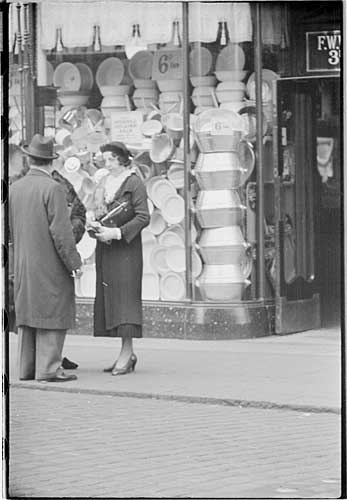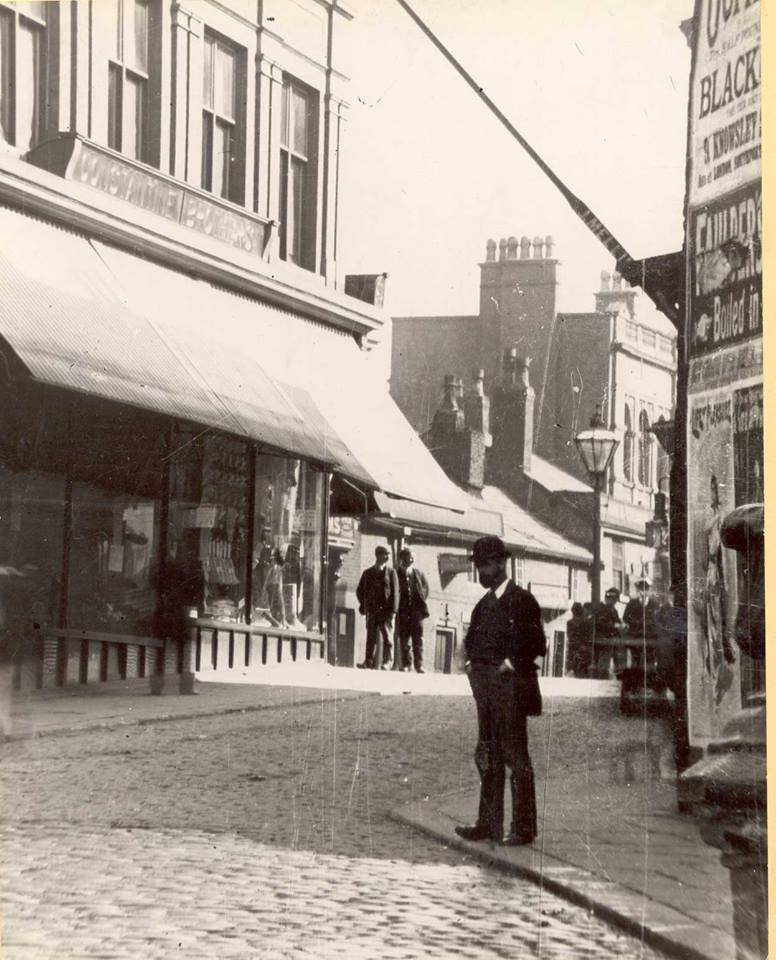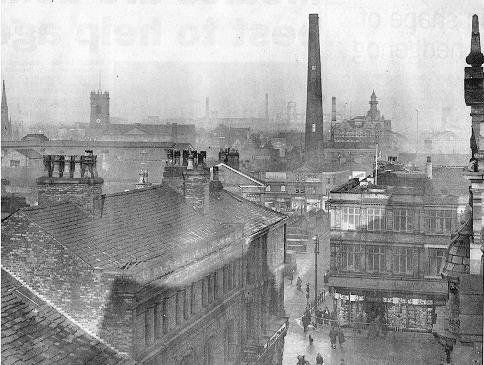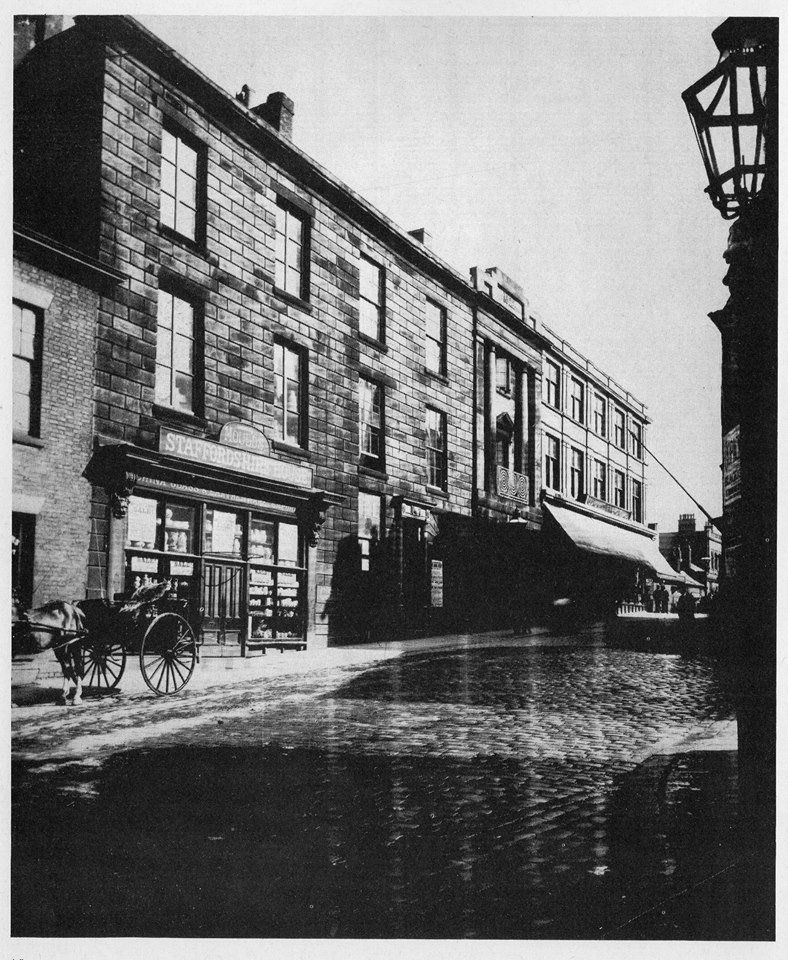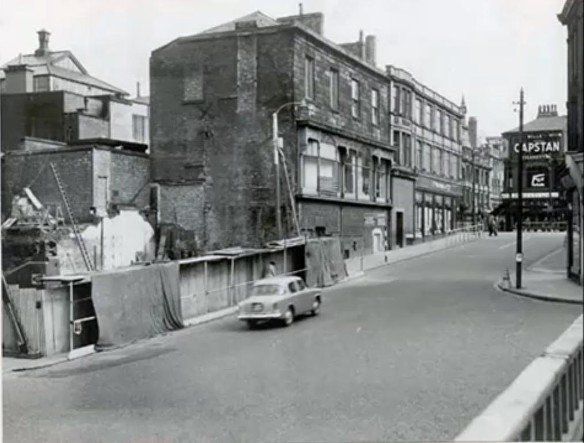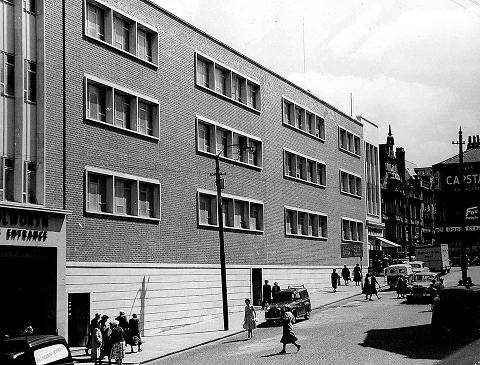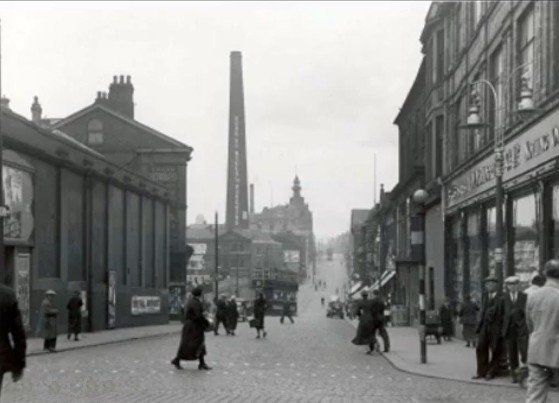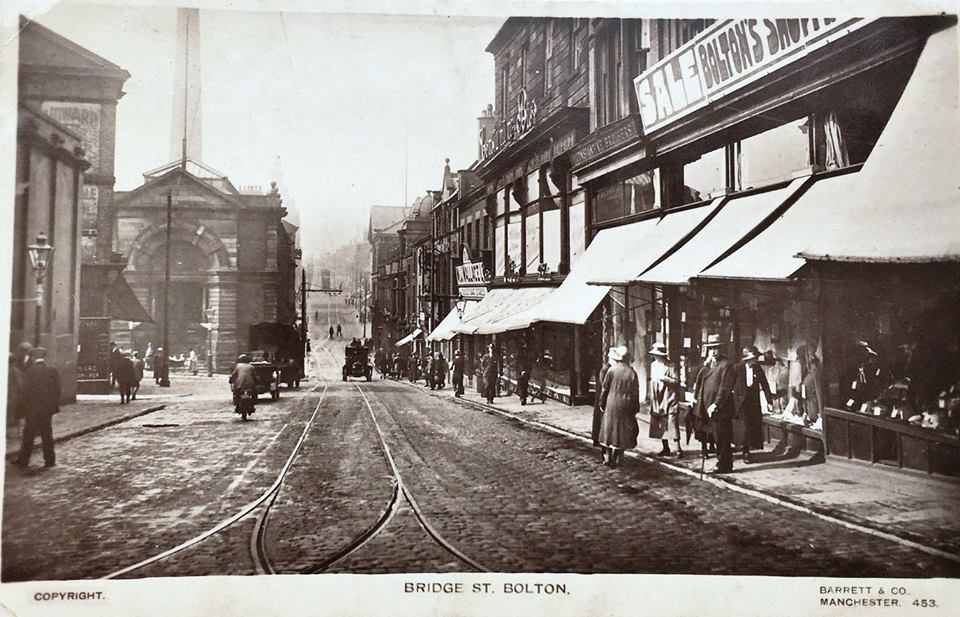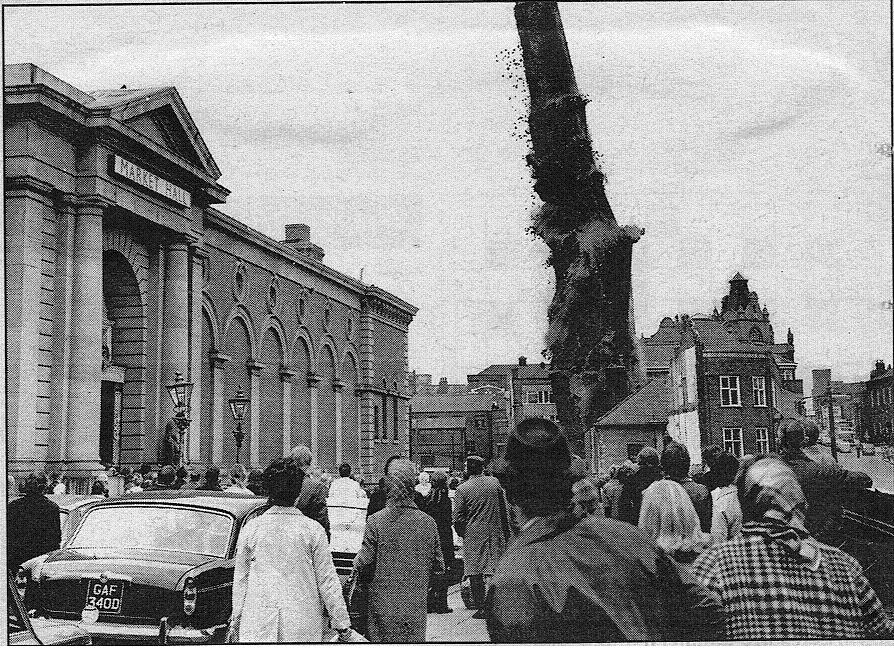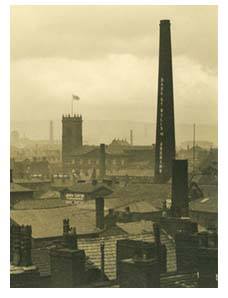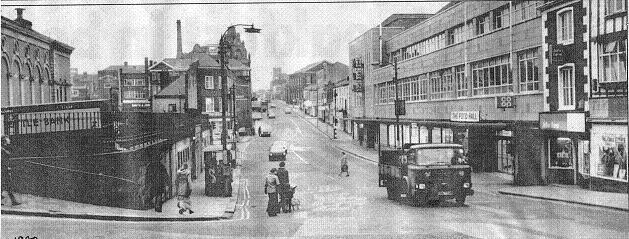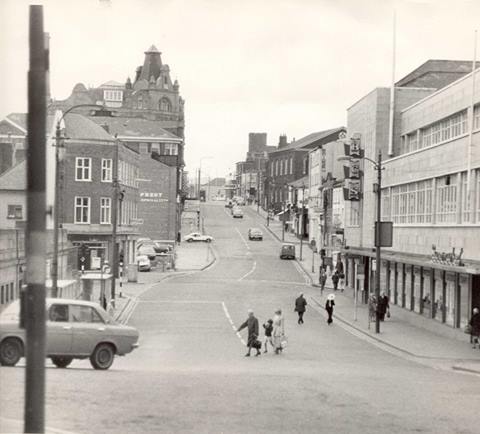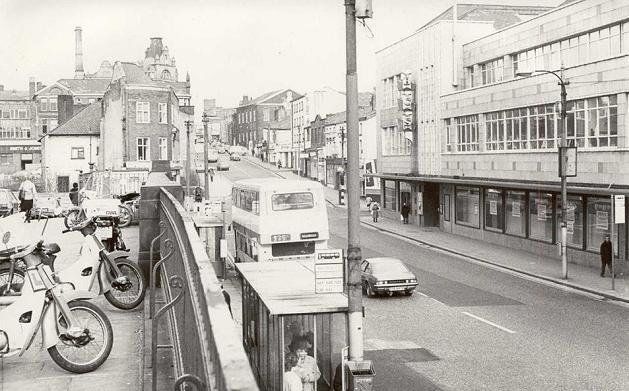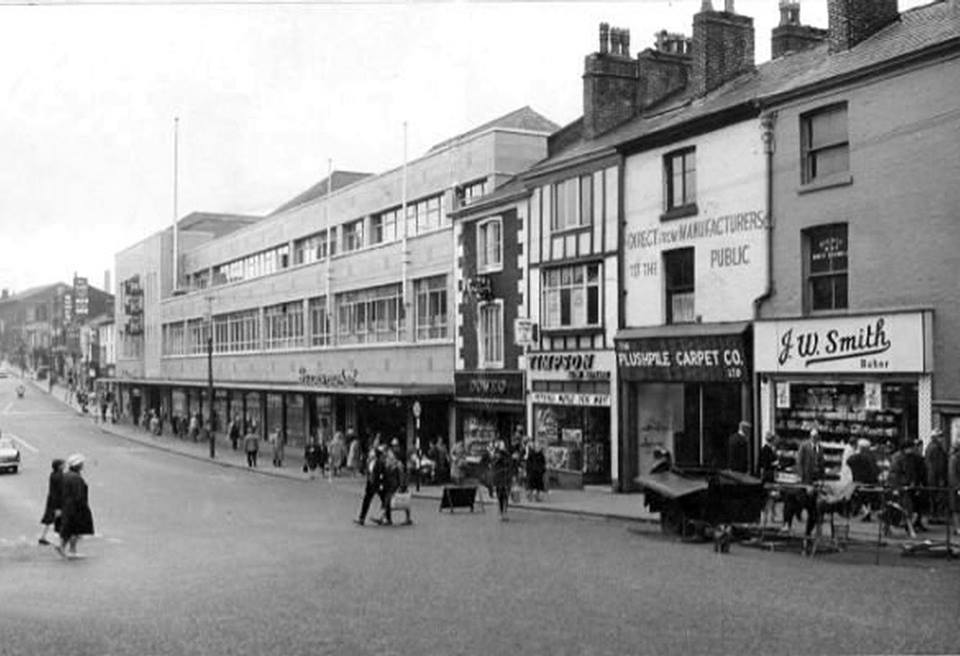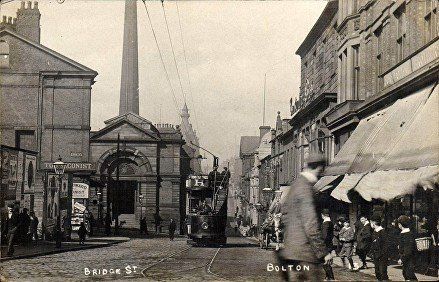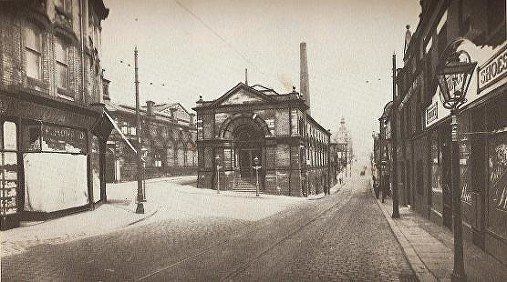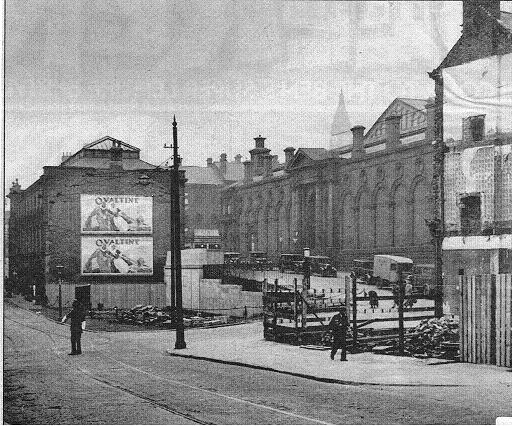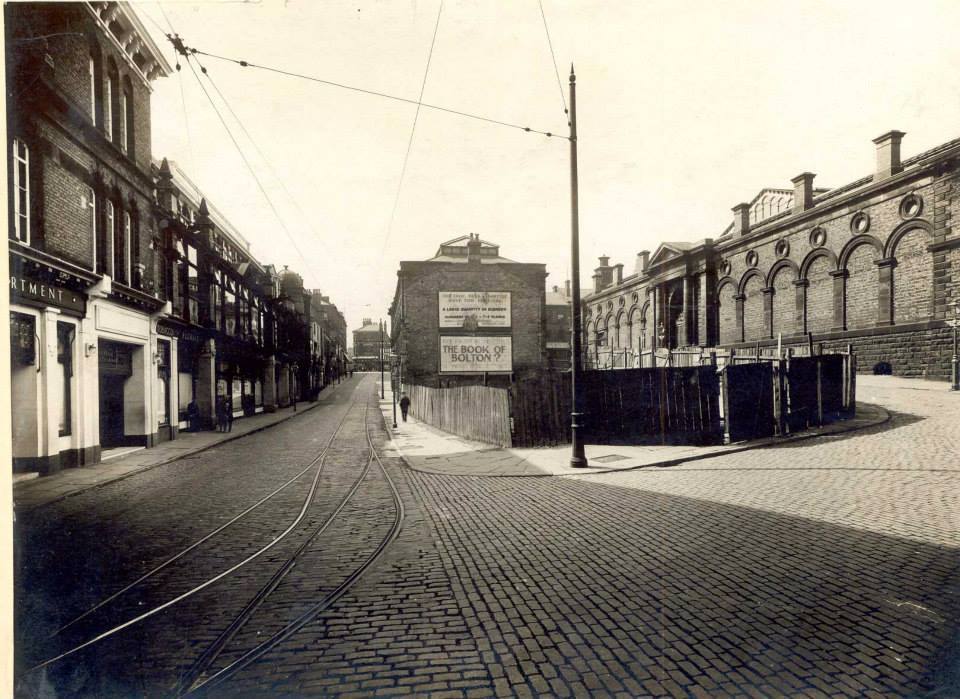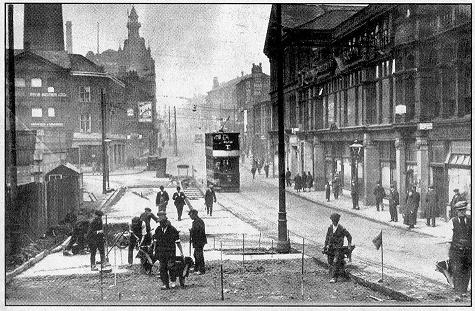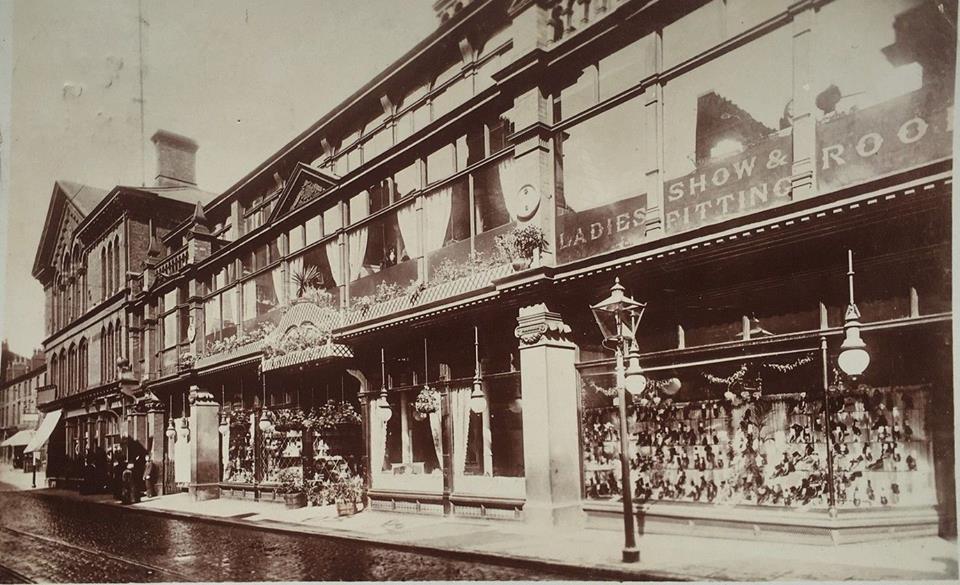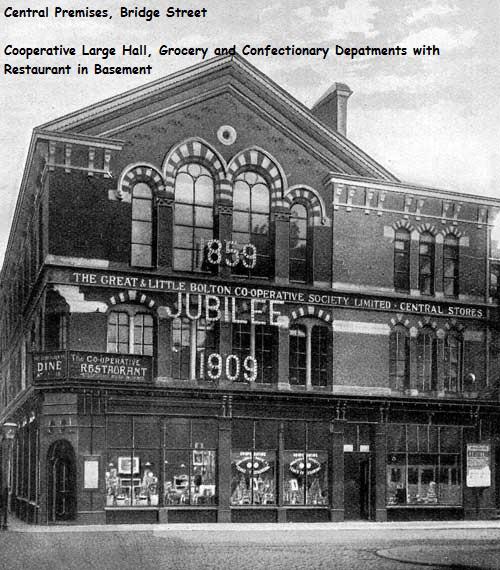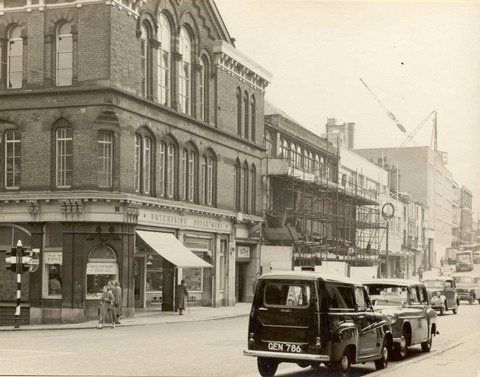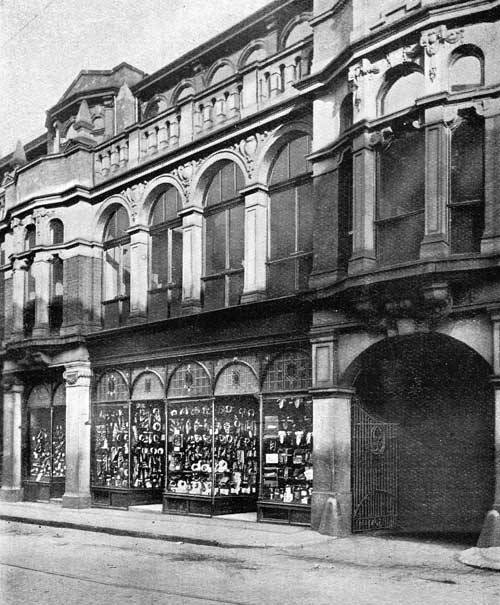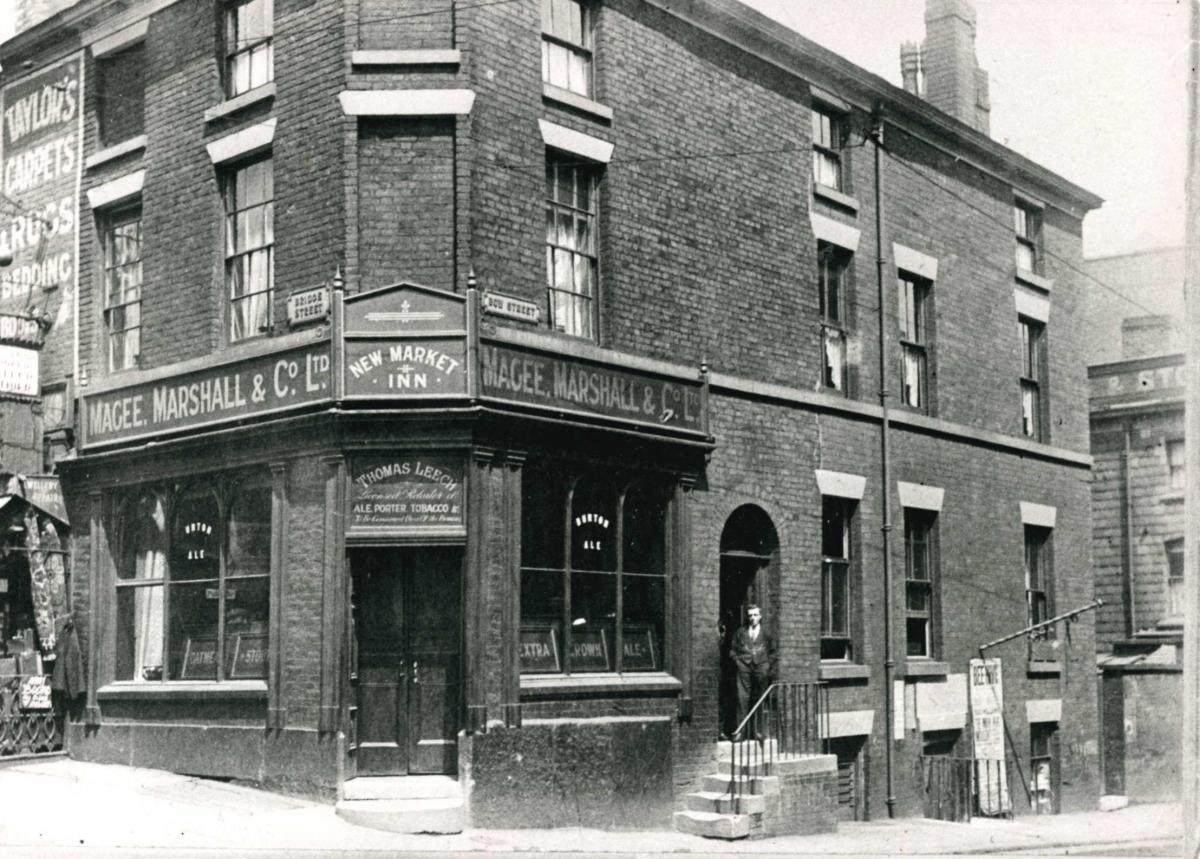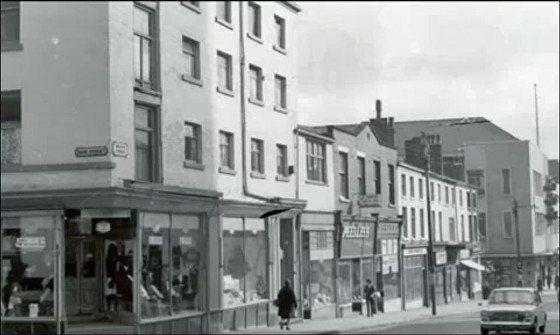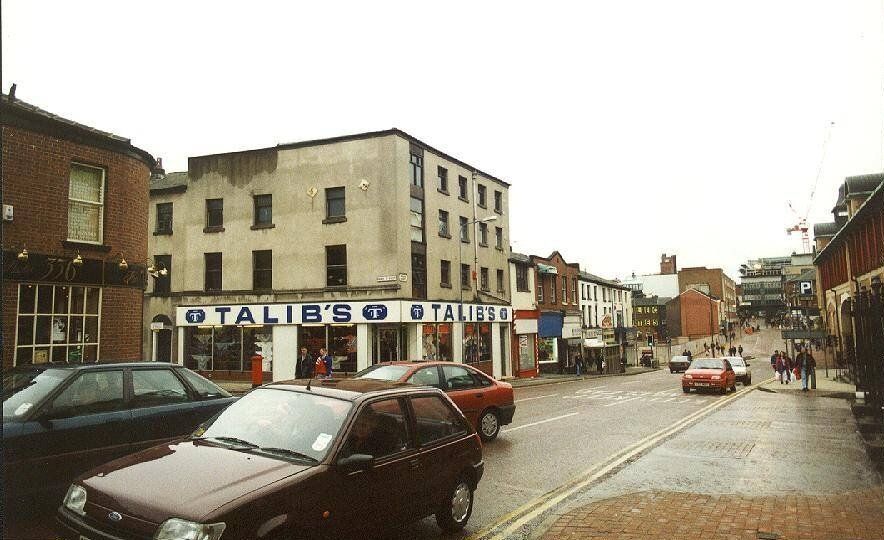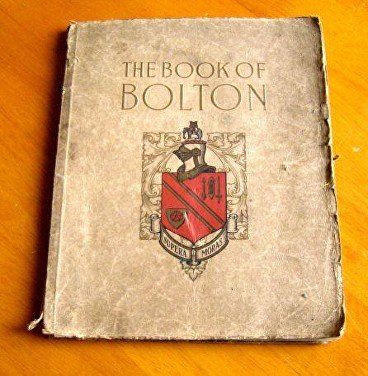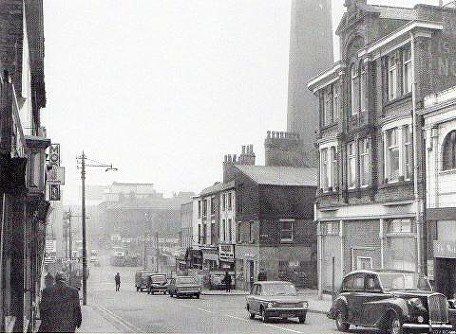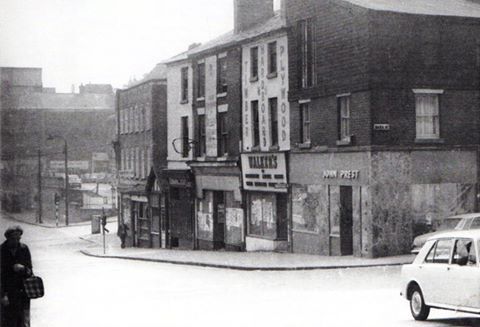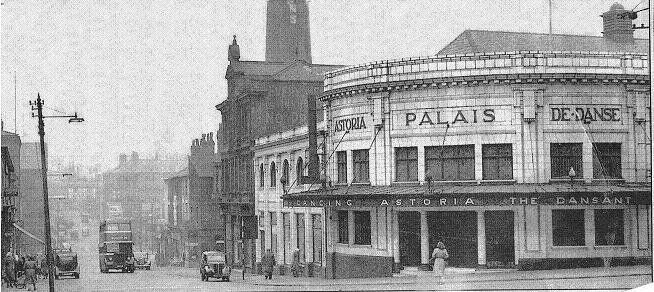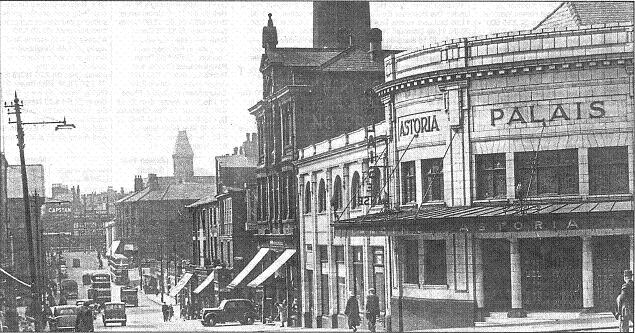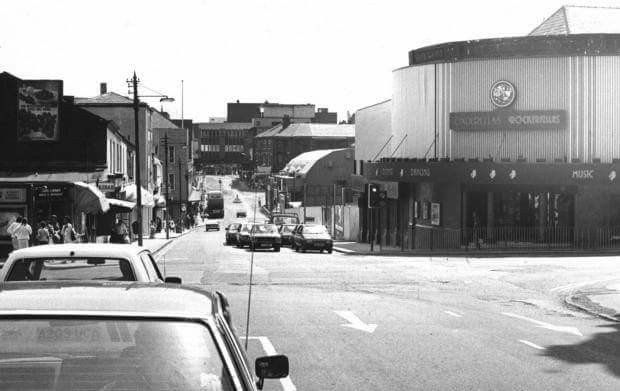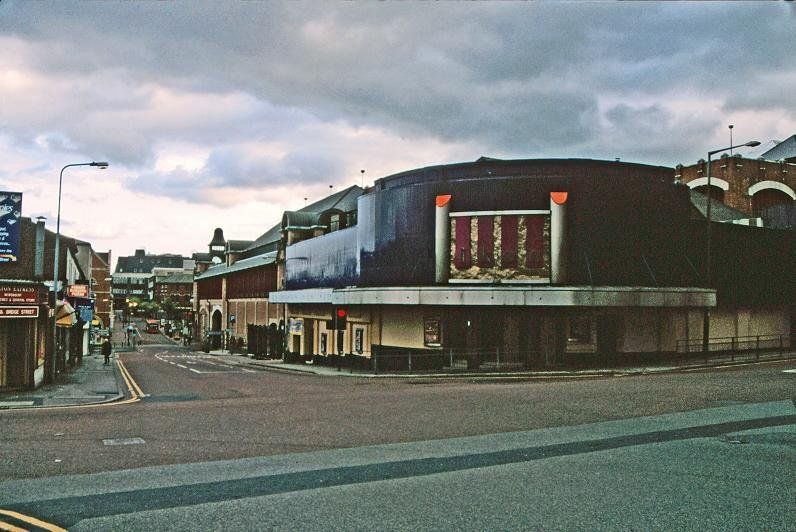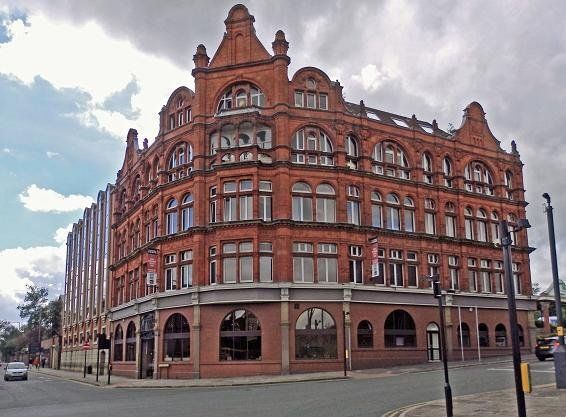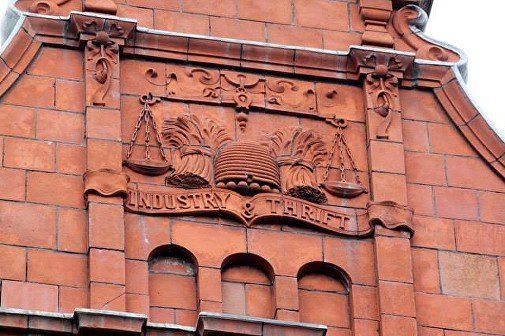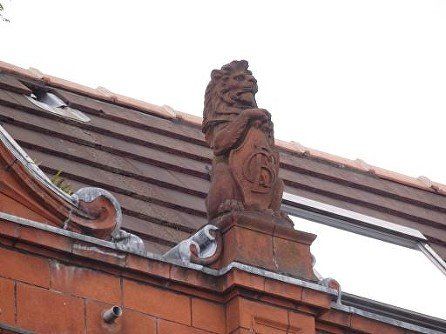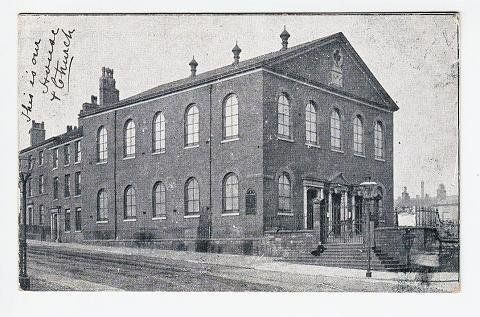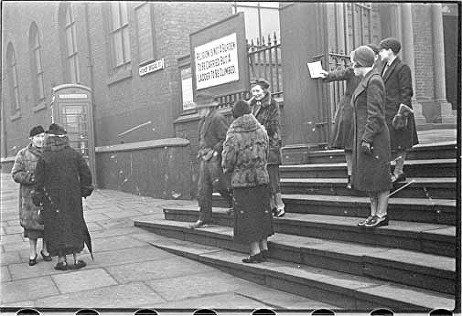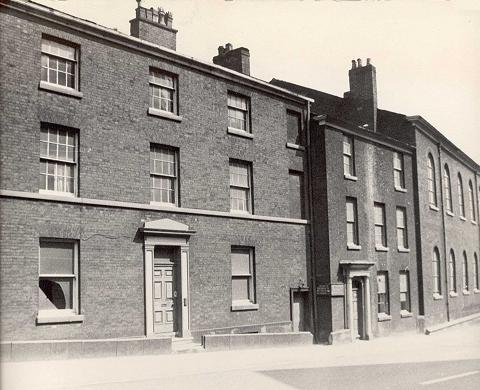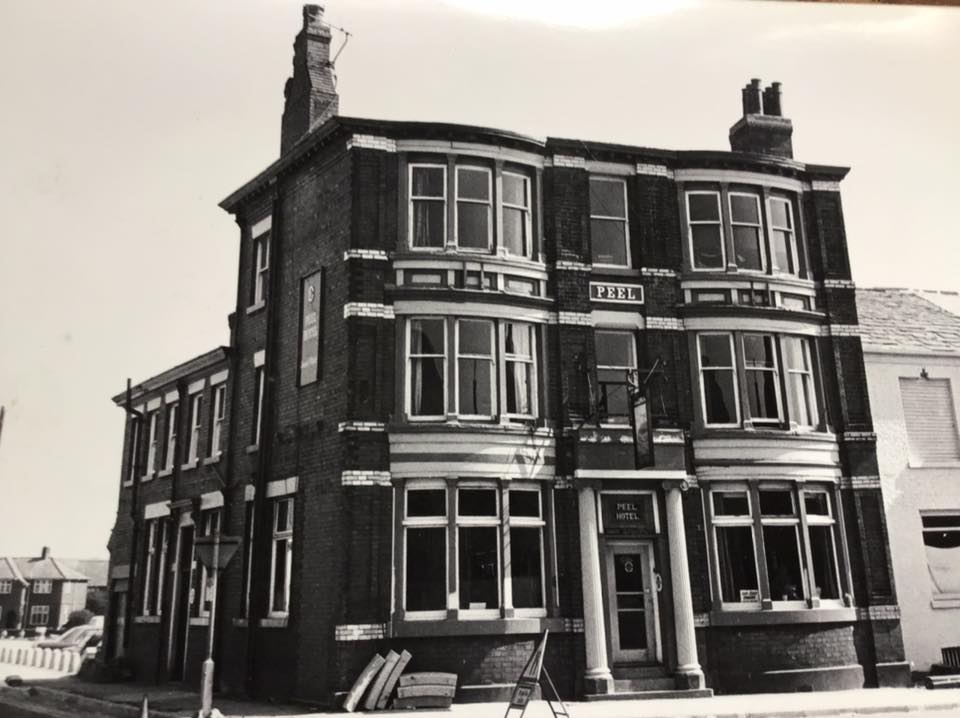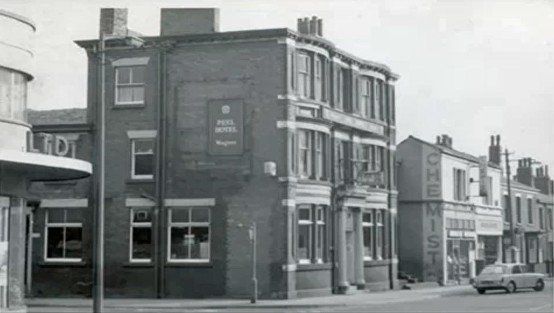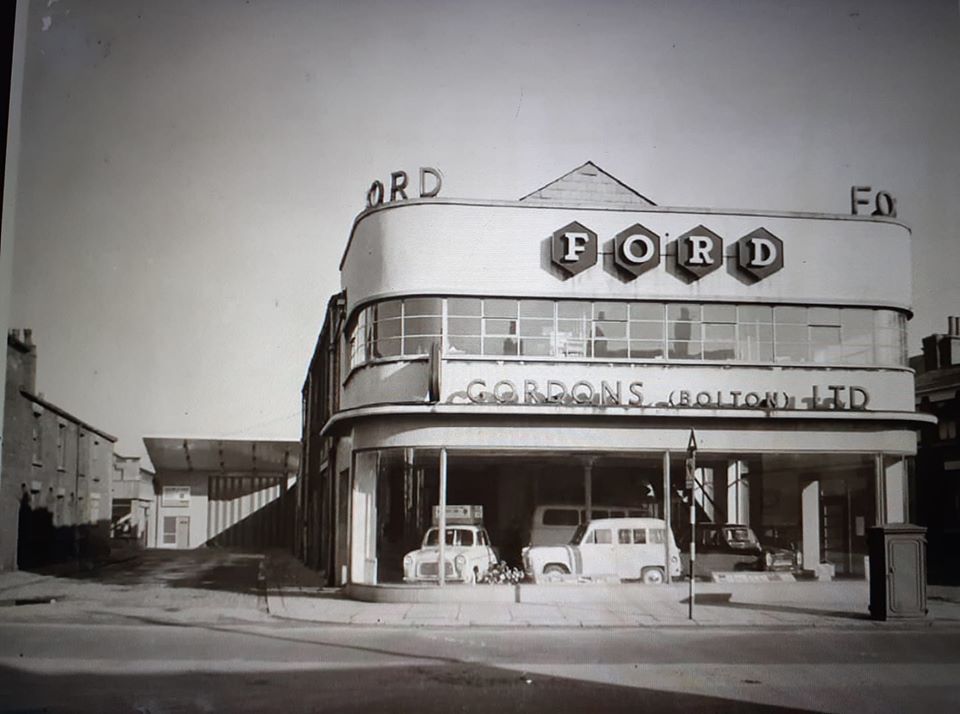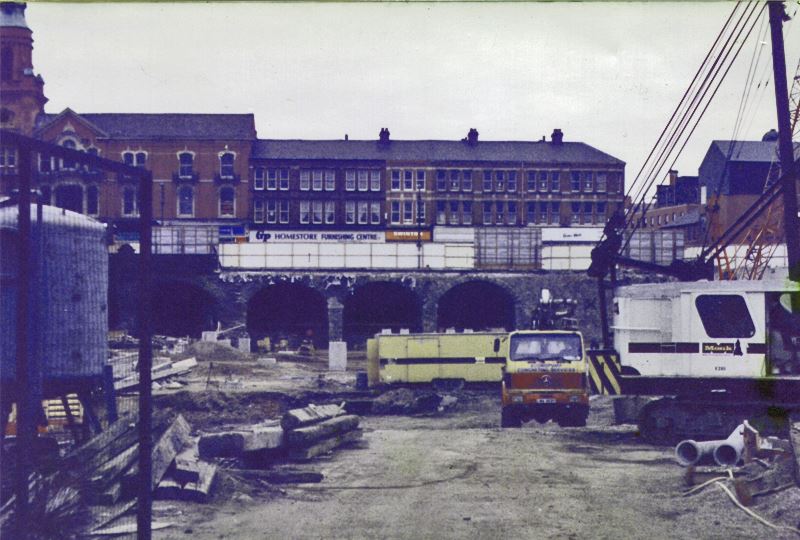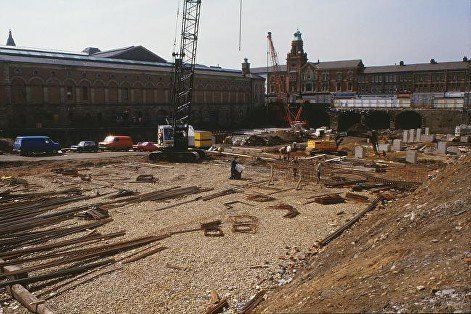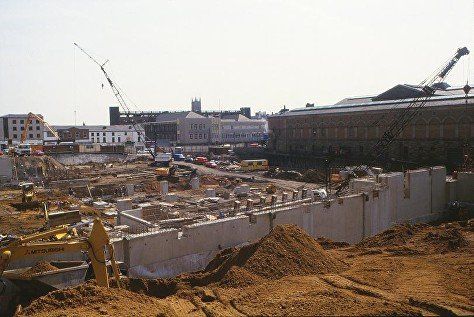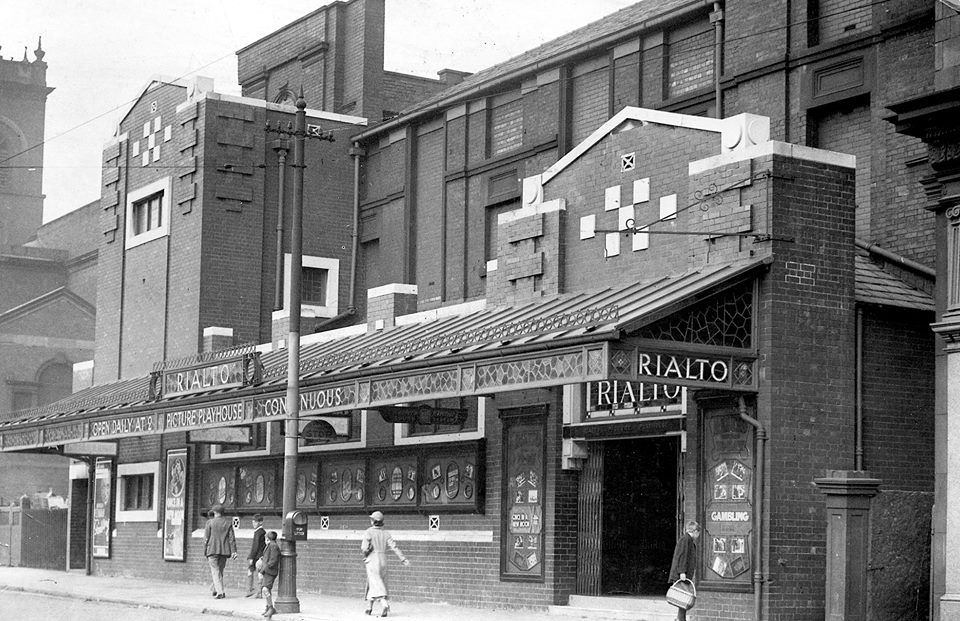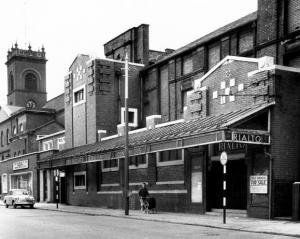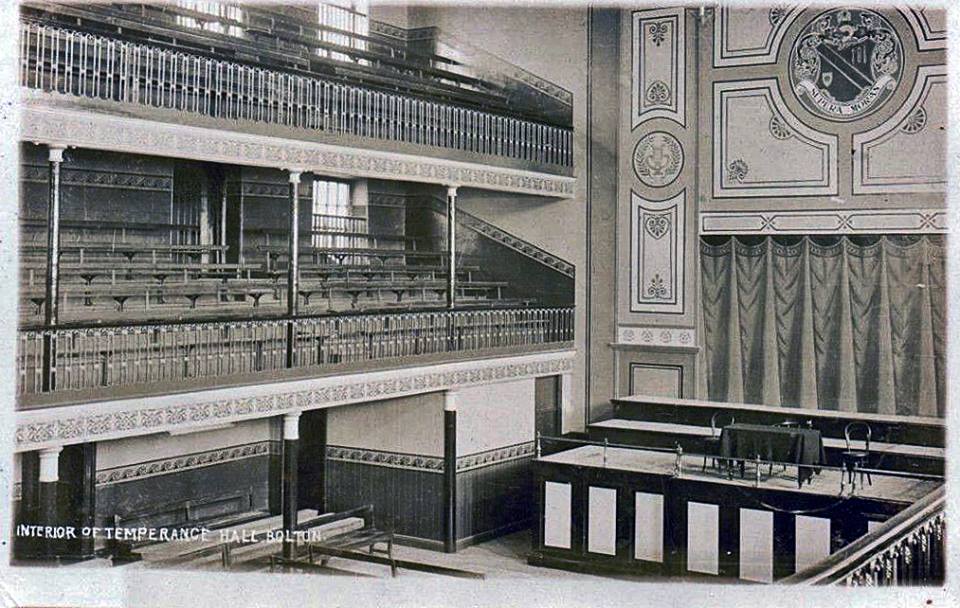A view from the roof tops of Mealhouse Lane, Woolworth’s, Bridge Street, Flax Mill chimney, the prescription pricing building (ex Co-op drapery) St Georges Church and extreme left, the spire of St George's Road Congregational Church (now URC).
The top of Bridge Street. At left, Staffordshire House selling “moulds”, china, glass and ? (They were having a sale).
Then what is probably just a house and to its right an unexpectedly elegant, pillared first and second floor with an entablature above.
On the Deansgate corner is Britannia House – probably Constantine’s.
Across Deansgate the corner of Mealhouse Lane can be seen without the bank building that stands there now.
Posted on Facebook by Edward Thompson.
Looking up Bridge Street from the Market Hall corner of Bridge Street and Corporation Street. The buildings which are standing are essentially the same as in the previous picture though the pillared building now with the door in the blank wall at ground level has been changed slightly. Woolworths are about to extend into the building in the centre of the picture. This might be 1957. We look across Deansgate and into Mealhouse Lane where the bank building which currently exists now seems to have been built and Dunn’s hat shop (with the Capstan advert) is now there. Interesting roofs at top left.
1960
Bridge Street, newly extended Woolworth’s. Bland and of its era but perhaps not actually ugly
Just before Christmas, 1960, the Co-op, then a couple of old shops and Woolworth’s.
On Deansgate at the top you see Dunne and Co before the site was redeveloped by Marks and Spencers.
Special offers at the Co-op, New Zealand shoulder of lamb, 2/- a pound; leg and fillet, 2/6 a pound.
Looking down Bridge Street, we see a tram , Flax Mill chimney, the “Prescription Pricing Building” (old co-op drapery store) still has its turret.
The wall on the left side could be the wall of the cinema (see next page).
This is after the widening of Bridge Street, the Fish Market is no longer there.
A postcard from David Whenlock's collection, posted in 1925.
On the right do we have Constantine's closing down sale prior to Woolworth's opening here in 1926?
16 May 1972 The Flax Mill chimney comes down. Note that a lot of clearance has already taken place just this side and to the left of the chimney leaving one lonely building on the corner of Bark Street and Bridge Street.
1980
Bridge Street, the familiar scene with the Market Hall but not the Market Place. The toilets are in use. The Co-op building on the right and the little shops that changed hands quite regularly, Phil and Carol’s fabrics (far right), what appears to be John Fane – I don’t remember this one, Alec’s second hand furniture at some point. (The chimney is NOT Flax Mill which was much nearer and has been demolished by this time.)
Now the Market Place has been built, Argos is on the corner of Bow Street, the Co-op is no more.
We do not yet appear to have had any demolition on the left prior to the building of the Market Place at this time.
From Angela Thompson's collection.
After May 1972, no Flax Mill Chimney. Probably 1980.
From David Whenlock's collection. Some more shops for you to remember. Probably 1980. No Argos on the corner yet.
1904 A picture from David Whenlock's collection of postcards.
Bridge Street with the old fish market, Flax Mill chimney and the Co-op drapery and menswear shop in the distance. Hoardings on the left probably shield recent demolition prior to the building of the Electric Theatre opened 13th August 1910.
A view we do not remember, the old fish market which was demolished in 1932/3 so that Bridge Street could be widened. What an excessively grand building for a fish market! And what a shame we have lost it. The fish market in Ashburner Street opened in 1932. There are stories of huge swarms of rats leaving the building as the demolition started. We see the familiar frontage of the Market Hall with Corporation Street on the left.
Demolition for the widening of Bridge Street. The retaining wall for Rushton Street with which we were very familiar, where there were toilets and where a number of buses stopped appears to be nearing completion.
Notice the lower advert. "The Book of Bolton?"
Why the "?" ?
Peter Lodge posted this picture of the 1929 edition in his possession.
c1931 David Whenlock picture – Bridge Street widening
Bridge Street widening
c 1931/2
What a grand place the co-op was c 1912.
Picture from David Whenlock's collection.
Bridge Street Co-op at corner of Bow Street 1859 1909
Jubilee – of what?
(not my caption in the sky!!)
Corner of Bridge Street and Bow Street, the Co-op Butchery Department, part of the co-op buildings, offices on Bow Street, grocery and entrance to Co-operative Hall on Bridge Street. This corner is now occupied by Argos.
Note the Woolworth’s extension is close to completion.
Picture from Denis McCann
The Co-op frontage on Bow Street, a splendid building whose site is now occupied by Argos.
On the other corner of Bridge Street and Bow Street, that is, across Bow Street from the Co-op (or now ARGOS) was the New Market Inn which closed in 1973.
More recently the Star and Garter occupied this corner but that had been demolished by 2019.
We have moved up Bridge Street from Bow Street to the the Bark Street junction.
We look down Bridge Street from the corner of Bark Street to the 1960s co-op building.
Talib's on the corner of Bark Street is remembered well by the ladies (and the men who were dragged along).
There is a big space the other side of Bow Street where Argos is being built.
At the top of Bridge Street across Deansgate, M&S is having an additional upper storey.
We are just up from Bark Street East looking back towards the Market Hall and Deansgate. On the right we see a tiny bit of the Palais then one of the many Co-op branches in the town centre, no longer a Co-op at this time. It is on the corner of Bark Street West with John Prest shoe shop on the other corner. We see the Flax Mill chimney from the north side.
John Prest (shoe shop) on the corner of Bark Street then Walker's wood shop though most people remember it a little higher up Bridge Street and on the other side of the road.
Part way through the demolition for the Market Place. John Prest’s shop still remains on the corner of Bark Street. It is possible to see across to the north wall of the Market Hall now completely inside the Market Place and straight into the picture you can see the length of Bark Street as it crosses Knowsley Street. All of this is now part of the Market Place.
Co-op Central Tailoring Department, often wrongly said to be the Drapery Department which is on the corner of St George's Road. Compare this with the picture two rows above and you will see this building on the corner of Bark Street just opposite John Prest.
Just up Bridge Street from Bark Street we reach St George’s Road and the Palais. All that facia still remains under the modern cladding which names it Ikon. It closed early 2012 and was bought by the owners of the Market Place early 2016. Petitions against its demolition continued into 2017 but by 2019 it was demolished.. We expect a hotel and carpark on the corner somehow integrated into the Market Place.
Immediately down from the Palais is the Co-op Central Tailoring looking far more imposing alongside other buildings than it did on its own.
A clearer view into the distance. Dunn's Hats is on the corner of Mealhouse Lane and the Gas Offices Tower protrudes above the roofs.
Above St George's Road Bridge Street becomes Higher Bridge Street and on the corner between these two roads, opposite the Palais is perhaps the grandest of the many Bolton Co-operative Society buildings. Click on any picture and navigate to see at a larger size.
1. Co-op Central Tailoring Department, opened 30 January 1897. The stone was red terracotta style from a brick works in Rubin in North Wales. To the left is the Bolton Temperance Hall. This was the first place in Bolton to show moving films on a regular basis.
Bolton Evening News 13th March 1906
Messrs Gale and Polden's Animated Picture Company are paying their first visit to the town this week and on Monday night the Temperance Hall was packed by an enthusiastic audience.
The pictures, which were far above the average seen in Bolton, kept the spectators interested for over two hours, a striking feature being the rapidity with which scene follows scene. A speciality of the exhibition was a series of animated photographs entitled "The King's service ashore and afloat."
By the end of the first decade of the 20th Century “Temperance” was already losing the enthusiasm of the public and the building was sold in 1910 and given over entirely to the showing of films. It later became the Rialto. The cinema we are familiar with, pictured lower down the page, had a new frontage but the main structure was still the Temperance Hall.
2. The store burnt down 1 June 1902, three years after opening.
3. It was rebuilt with an overall similar appearance though it was different in every detail. The original building with the larger windows looked better. The new building was again given a “pagoda”. It reopened 27 Feb 1904 .
4. (C) WDC July 2016. The building is almost unchanged except for the removal of the pagoda. Norweb owned the building from 1969 until the PPA (Prescription Pricing Authority) took it over in the 80s. It is now part of the Holiday Inn whose forecourt can be seen to the right.
If you look closely at the top of the building the old co-op mottos are still there : "Industry and Thrift" and "labour and wait". There is also still a terracotta lion with the letters BCS(Bolton co -op socty) and there are numerous carvings in the stonework above the second floor, of scales, bee hives and sheaves of corn, all old co-operative symbols.
Diagonally opposite the Palais was the Bridge Street Methodist Church. The picture is from David Whenlock's collection of postcards and was posted 1908. "This is our house and church". When the church closed its organ went to the Great Hall of the Girls' Division of Bolton Scholl. The building has been a casino for many years.
a picture of people leaving the Church, probably from the Spender Collection (all rights Bolton MBC) so 1937.
The Methodist Church and the adjoining block of houses - from Angela Thompson's collection.
The Peel Hotel on the corner of Higher Bridge Street and Falcon Street. Topp Way was built straight through the Peel Hotel.
Houses in the distance are at the corner of Kay Street and Turton Street.
On the right is the art-deco showroom of Gordon's Ford dealers. Gordons became Bristol Street Motors in 2016 and the art deco building was demolished in 2017. The street on the left is Falcon Street which became the eastern end of Topp Way between Higher Bridge Street and Kay Street.
The Palais corner but from the air at the time of the building of The Market Place. The Market Hall is at the left and the Palais is on the corner – and is still there in 2017 though its days are probably numbered. See also the Prescription pricing building, Congregational Church, St George’s church / craft centre, Bath Street car park which became a huge multi-storey car park in 2011.
Picture posted on Facebook by Phil Wadeson
Looking across the Market Place site from Bridge St to Knowsley St. Most people on Knowsley Street think they are at ground level and are unaware that they are actually on a viaduct about 20 feet above the River Croal. (More pictures of the river at this point on the Knowsley Street page.)
(C) W D C April 1986 from Bridge Street looking towards Knowsley Street and the Victoria Hall
(C) W D C April 1986 Knowsley Street looking across to Bridge Street with the co-op, then the Bow Street car-park, then the Parish Church.
The Rialto Cinema on St George's Road.
1. It is still in use but “gambling” on the far right poster? posted on Facebook by Denis McCann.
2. The building is now for sale.
In both pictures St George's Church can be seen at the left.
In both pictures behind the Rialto facade is the original front wall of the Bolton Temperance Hall which opened New Years Day 1840. It was the venue for a "Promenade Concert" on the occasion of the dedication of the Samuel Crompton statue in Nelson Square. It was the first place in Bolton to show movie films on a regular basis. By the early 20th Century the Temperance cause had lost much of its popularity and in 1910 the building was sold to a film screening company.
The interior of the Bolton Temperance Hall
One of David Whenlock's postcards.
On the next page we continue our journey along Deansgate.

